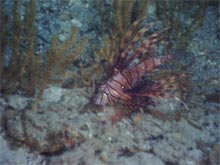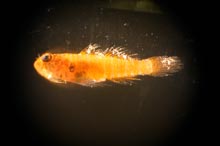
Scientists diving in the submersible stumbled upon a red lionfish (>Pterolis volitans). This predatory fish with highly venomous spines is an invasive species native to western Pacific waters. Click image for larger view.
Return of the Lionfish!
August 7, 2003
Jeremy Potter
NOAA Office of Ocean Exploration
It’s déjà vu! Almost one year ago exactly, I was here at sea with many of the same determined scientists from South Carolina. I sailed on the same Harbor Branch Oceanographic Institution research vessel, and sat at the same stool at the same bench in the same lab. Today, staring at the videotapes from the sub on the same video monitors as last year, I laughed once again at the sly cleverness of the elusive lionfish (Pterois volitans).
Last year’s log not only explained what little we know about the introduction of this highly venomous fish to Atlantic waters, but also summarized many of the serious concerns related to invasive species in general.
Multiple sightings during the Islands In the Stream 2002 (IIS 2002) expedition provided the first video evidence documenting not only the existence, but also the apparent lightning-fast spread, of this fish accidentally transplanted from western Pacific waters. Given how many have been spotted in such a limited number of visits to the sea floor, it’s tempting to dub them the marine equivalent of bunny rabbits!

While pursuing a larger fish, scientists happened to capture this unsuspecting goby, just 1.5 cm long. Image courtesy of Dave Wyanski, SCDNR. Click image for larger view.
Photographic evidence of the lionfish is valuable, but scientists would love to get their hands on one of these predatory fish. All of last year’s attempts to capture a specimen were unsuccessful. Today, the sub pilot relived those frustrations all over again. Much like the Road Runner, the fish easily pirouetted around anything the multimillion-dollar sub threw at it.
Today’s sighting was accidental. The area we are operating in now, 32o 05N 79o15W, is several hours away from our primary target, the Charleston Bump. This morning, 25-knot-plus winds and 4- to 6-ft seas made launching the Johnson-Sea-Link II submersible at the Bump too dangerous. Rather than having us sit on our hands and wait out the weather, chief scientist Charlie Barans and expedition coordinator John McDonough decided to steam northwest, out of the Gulf Stream and into shallower water. They hoped that shallower waters would prove more conducive for submersible operations. They chose wisely.
Central to many of the objectives for this cruise is the examination of high- relief, hard-bottom habitats. It is precisely in and around these rocky outcrop exposures that organisms congregate. With that in mind, hearts sank when we arrived on site in mid-afternoon and fathometer readings indicated a virtually flat, sandy bottom. The site for the impending dive was dubbed “The Great Plains.”

This species of brittlestar (Astroporpa annulata) is related to basketstars and lives clinging to soft corals. The white rings are made up of tiny hooklike spines to help it hang on and capture food. Image courtesy of Project Oceanica. Click image for larger view.
Ironically, the name was even more appropriate than we realized. Besides an expansive, pancake-like flat bottom, scientists aboard the sub videotaped and captured a treasure trove of invertebrate life. Despite the dearth of rocky relief, scientist Fred Andrus noted that anything growing up off the bottom, even small soft corals, attracted a variety of other life. The attraction of marine organisms to areas with bottom relief is precisely the reason scientists called last year’s Island in the Stream expedition "Underwater Oases."
Last year, scientists observed six lionfish during three of nine shallow dives along shelf-edge reefs off South Carolina. Today’s encounter at 250 ft is slightly deeper than any of last year’s sightings. Not only is there no reef on the Great Plains, but it’s a random dive location. It’s almost like throwing a dart at a map, diving to the bottom, and spotting one. If we hit one with one dart, are they rare? How many of them are really out here? And more importantly, what impact are they having? So many questions still remain.
(Postexpedition note: Scientists discovered a second lionfish hidden amongst the coral while viewing the dive videotapes.)
























